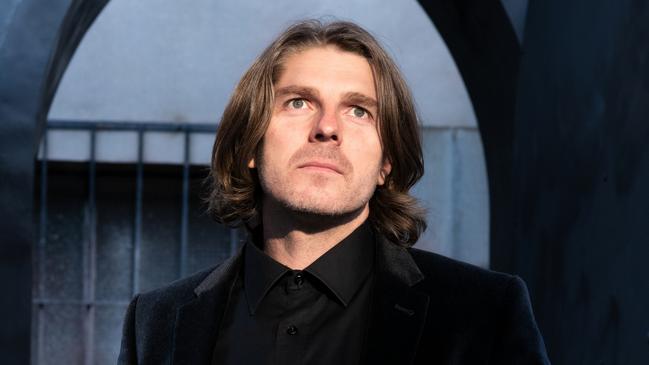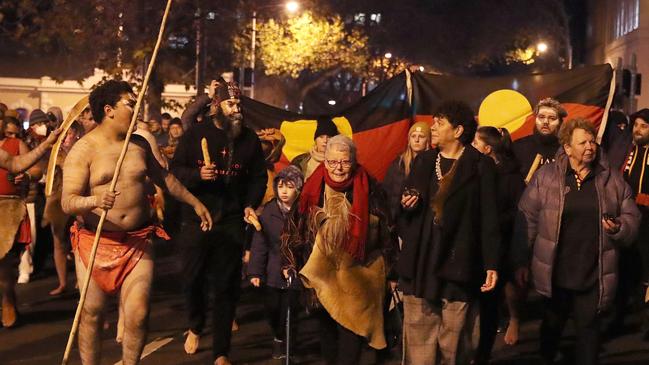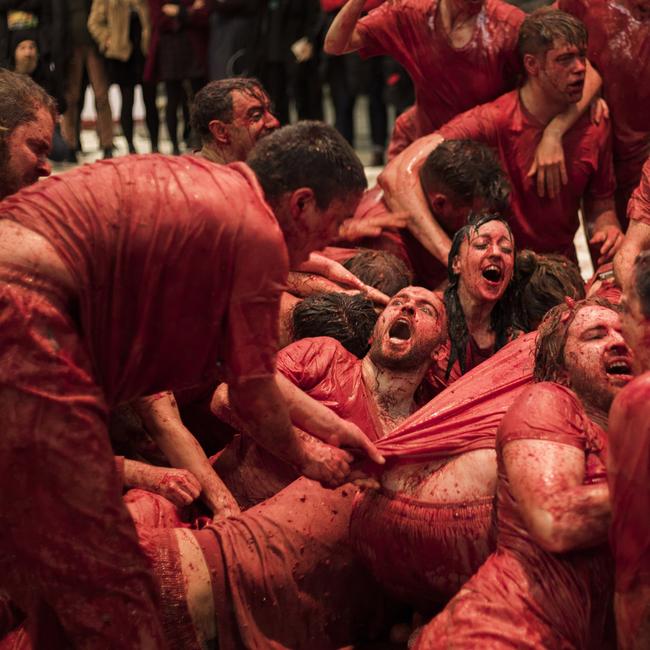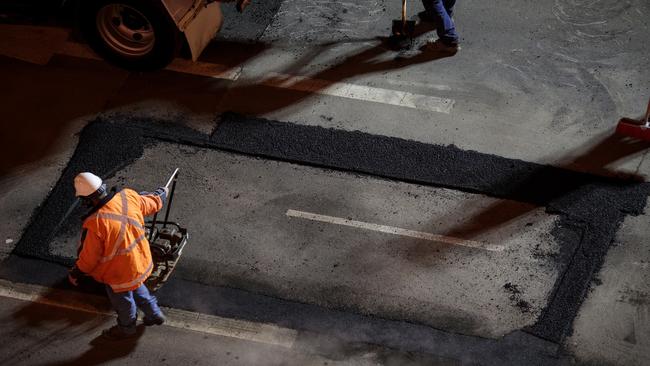Dark Mofo director considers his future after The Mistake
A year on from a controversy that almost saw the Hobart midwinter arts festival cancelled — figuratively and literally — creative director Leigh Carmichael is left to wonder: was it all worth it?

“I have been left wondering about the festival and about art, and about where the place is in Australia that might program confronting works in the future. I have been left wondering whether there is still a role for Dark Mofo to continue to play in that space. I am left wondering … if not us, then who?”
Leigh Carmichael, on the eve of the final weekend of his ninth festival as Dark Mofo creative director, is in a philosophical and serious mood.
He is talking about the future of the Hobart midwinter arts festival; about what he perceives to be a lack of critical engagement in the Australian cultural sector; and about the event last year – let’s call it The Mistake – that threatened Dark Mofo with cancellation, of the literal and figurative kind.
So, hold on. Is Carmichael seriously suggesting the festival’s future is in doubt? Well, no. Mofo is not going anywhere.
But when pressed about how the three-week art and music event looks going forward, he cannot speak with certainty about what shape it will take.
“The truth is, after 2023, I don’t know.
“Put it this way, something was written about me the other day (in The Australian’s The List – Arts and Culture magazine) that said ‘... the sector will be watching what Carmichael does with interest’. Well, the reality is I am watching the sector to see what it does with us.”
And Carmichael’s future?
On that count he is more forthcoming.
“Next year is my 10th festival. I feel like that is a lot of festivals and I think there is a time to hand things over.

“I haven’t really made a decision. And I’ve absolutely loved this period of getting the festival off the ground and getting it to where it is: it is challenging and incredibly rewarding. So I’m going to have to think about that. But 10 years and 10 festivals feels like a nice number. I’m pretty exhausted.”
To fully understand that exhaustion, or at least its critical point, we have to go back 16 months, to the launch of the 2021 festival, when everything changed.
Carmichael is the first to admit it. The Mistake.
It’s an aberration for which he has spent more than a year atoning, publicly and privately. The Mistake was not, to be clear, the commissioning last year of a controversial Santiago Sierra work – subsequently cancelled amid a national public furore – asking Indigenous Australians to offer their blood with which a Union Flag would be doused. That artwork, Carmichael insists, still has artistic merit.
No, The Mistake was not listening to Aboriginal Australia, to the local community, to his own staff. The Mistake was compounded by a “tactless” marketing campaign, in the festival’s social media channels – criticised as having been deaf to the island’s brutal colonial past – shouting: “We Want Your Blood”.
Within days the Twitterati, and then what seemed like half the country, was shouting for Carmichael’s.

But The Mistake has had a deep impact on Hobart’s midwinter arts jamboree. And not just on visitor numbers and programming, both of which in 2022 were far more conservative than in the boomtime pre-pandemic years, when tourism and business operators estimated the festival generated upwards of $100m annually. Arguably The Mistake, fairly or not, has fundamentally compromised both the festival’s reputation and its raison d’etre.
Mofo, since its bold inception in 2013, has moulded itself almost in opposition to the traditional major state festivals.
It quickly made a name for itself as the little festival that would: unafraid to program the radical, the risky and the risque. Indeed, in recent years it even shed all ties to sponsors in order to liberate itself of commercial constraints.
In the words of Carmichael at the time, the decision was made to allow the festival to “focus purely on the art”. And its programs have unquestionably been bold and uncompromising.
Until 2021, the right to exhibit and interrogate art – controversial and confrontational as it may have been – always prevailed.

The truth is, for Dark Mofo, controversy has not just been good for business (many would argue it has been good for art, too) – it has been its business.
Its own history is instructive. Mofo refused to yield to intense community pressure in 2018 when local churches were affronted by the red illuminated inverted crosses, often interpreted as a symbol of Satanism, installed around the city. (It inspired some conspiratorial wits at the time to note an anagram of Tasmania is “I am Satan”. That same year organisers fought hard to overcome fierce community opposition when they interred for three days 73-year-old performance artist Mike Parr beneath Hobart’s main street. The festival was steadfast in its resolve in 2017 that it should stage Austrian artist Hermann Nitsch’s six-hour long performance piece featuring a live orchestra, 500 litres of blood and the ritual crucifixion of “disciples” on a freshly slain bull carcass. That show was almost derailed by protesters who had bought up tickets to the show in order to disrupt it.
Unsettling and delighting the locals in equal measure has been Dark Mofo’s stock in trade. And so the issue with Union Flag, Sierra’s proposed work, became a philosophically paradoxical one: the secret to Dark Mofo’s past success had overnight become the catalyst for its future undoing.

“Careful what you wish for, I guess …” says Carmichael, ruefully, of Dark Mofo’s formerly notorious guerrilla social media campaigns. “The marketing for Union Flag was insensitive, and very poorly crafted, and I really regret that aspect. And I have to take full responsibility for that. And I have done that. It was a reallypoor version of clickbait. So we got what we deserved last year.”
What they got was a backlash – including death threats for Carmichael – from punters and the Indigenous community, which took umbrage at the idea Indigenous Australians should spill any more blood in the name of anything, least of all the artistic ideals of a Spanish artist. Then came calls for a boycott that seriously affected ticket sales and performances.
The festival apologised, eventually, and cancelled the piece. In April it announced a $60,000 seed fund for Aboriginal artists and reportedly has worked hard to mend bridges with the Indigenous community. That focus has seen the employment of Indigenous advisers at the festival, and the programming of Indigenous-specific work, including the Reclamation Walk on its opening weekend. The headline attraction at this year’s festival, too, was arguably the most famous Aboriginal identity on the planet in the rapper The Kid Laroi. Carmichael says he is
proud of the program and the steps the festival has taken to listen, but the events of last year have humbled and affected him deeply. Has it made him gun shy?
“No one has ever forced us to not take the risks. But I think we do feel a little more timid than we have in the past. I think the program this year is definitely a little safer. I don’t know what it means,” he says.
“It’s a tough one and I’ve been thinking about it a lot ever since we managed to get our way through the Union Flag situation and think about who we are and it is a challenge because we’ve really prided ourselves on being courageous and taking on some of the artists and projects that the major institutions just can’t or won’t.
“So I think it could mean there is a shift. I hope that we can work through it but, you know, no one here is ready to go through that experience again.”
W W W
Carmichael is a well-regarded figure in the Australian cultural establishment. He has taken Dark Mofo from unknown outlier on the arts calendar to a major player, commissioning internationally lauded artists such as Marina Abramovic, Laurie Anderson and members of Pussy Riot, among many others, during the course of his tenure. He is on the board of The Australia Council and has a deep interest in the arts at a national and international level. But the Sierra fallout has given him more questions than answers. Carmichael is concerned more broadly about a lack of critical engagement with art in Australia.
He cites two examples of art-as-controversy in Australia: Bill Henson’s photographs of children, an exhibition of which was shut down by NSW Police and famously condemned by then prime minister Kevin Rudd as “revolting”; and American artist Andres Serrano’s work Piss Christ – an image that depicts a plastic crucifix submerged in the artist’s urine – whose display at the National Gallery of Victoria saw then-Archbishop George Pell try to seek its banning under an obscure blasphemy law.
In those cases, as in Mofo’s, Carmichael says there was a dearth of solidarity, let alone support, from the cultural sector.
“I didn’t see the reaction to Union Flag coming with the ferocity that it did and I didn’t see it coming from where it came from.
“Senator Eric Abetz, for instance, spoke up about the flag being desecrated. And then, yes, I was surprised to see so much opposition from the cultural space. It came with a force that we certainly weren’t expecting and hadn’t been seen in Australia for quite a while.”
The Hobartian says the isolation he and the festival felt in the wake of the controversy speaks to a deeper issue in Australia around free speech.
“I think we need to look at cultural leadership in times of controversy and there needs to be louder voices in relation to the importance of freedom of expression. It’s not something we talk about a lot in Australia because we are really relatively free to be able to express ourselves. But I think, you know, we want more artists, not fewer, to be courageous and to be taking risks and challenging us as often as possible.
“And maybe there’s an argument to be made that there’s not enough controversy in Australia, and perhaps there’s room for other folks at some of the major institutions to take on some difficult work. I think it’s important.”
Carmichael says ignoring difficult, confrontational art risks subjugating the roles of those in the creative industries.
“I do strongly believe in how essential art is and also in the artist’s role in society, which is often overlooked. It’s incredibly important in terms of challenging us in the way we think and challenging social norms,” he says. “Art is a relatively safe space to be able to do that.”
It’s not always a safe space, however, as Carmichael knows too well. So, back to The Mistake. Is it behind us now? It hasn’t, as some have suggested, signalled a terminal decline for Australia’s edgiest arts event?
“I am always learning and engaging,” Carmichael says. “But if anyone is shutting us down, it will be us. No one’s challenging our right to speak, or to express ourselves. It’s just that the consequences that come with it can be pretty extreme.”
The festival is funded jointly by the Tasmanian Government and David Walsh, the founder of the Museum of Old and New Art – of which the festival is an offshoot. Next year represents the second of a of three-year government funding agreement. What happens next, says Carmichael, remains to be seen.
“Beyond next year I don’t know. I think there will be some questions. We will have to sit down with government and community and look at the festival, how it is curated and the format. We will need to plot a direction for whether it continues doing what it’s been doing or whether there’s a change.”
Carmichael says, however, he expects the winter solstice to be the centrepiece of any future Mofo iterations.

“And I can’t imagine the Winter Feast being stopped. But I guess we’ll see how she goes.”
Carmichael sighs and exhales. “I just think some things are important to say.”
All characteristic grace and uncharacteristic caution, Carmichael is a man caught between two ideals: honouring the philosophical integrity of the festival he brought into the world and securing its future for the local community, keenly aware that each programming decision — or indecision — risks taking Dark Mofo closer to the place it has always rebelled against: the middle.
Dark Mofo runs until Wednesday in Hobart.




To join the conversation, please log in. Don't have an account? Register
Join the conversation, you are commenting as Logout